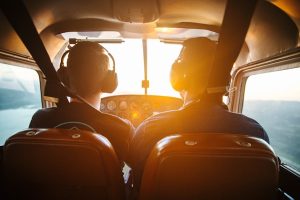Career
Flying High: How to Get Your Commercial Pilot’s License
Many of us dream of flying planes in the limitless sky. The ultimate dream combo for many is the excitement of getting ready for a flight, the take-off, the effortless gliding in clouds, and a smooth landing. However, have you ever wondered how this dream can transition into reality and become something you can earn a living from?
Obtaining a commercial pilot’s license is a dream many aviation enthusiasts share. Whether it’s the thrill of commanding an aircraft or the freedom of soaring through the skies, becoming a commercial pilot opens up countless opportunities. However, aspiring aviators can take time to navigate the process of obtaining this license.
Here are all the necessary steps and information needed to help you achieve your goal of becoming a licensed commercial pilot:
1. Understanding the Requirements:
- a) Age Requirement: Typically, aspiring pilots must be at least 18 years old before beginning to obtain a commercial pilot’s license.
- b) Educational Background: While not mandatory, possessing a high school diploma or equivalent can strengthen your application and provide a solid foundation for further training.
- c) Medical Fitness: Before pursuing your license, you must undergo medical examinations conducted by authorized aviation medical examiners. These tests ensure you meet the physical and mental fitness standards for operating an aircraft.
- d) Flight Experience: To pursue a commercial pilot’s license, you will need additional flight experience after obtaining your Private Pilot License (PPL). Specifically, many aviation authorities require between 250-300 hours of flying experience before entering commercial training programs.
2. Private Pilot License (PPL):
Before jumping into commercial pilot training, aspiring aviators must earn their Private Pilot License (PPL). This vital stepping stone serves as the foundation for further education. The PPL course includes theoretical knowledge covering aerodynamics, navigation principles, and communication procedures.
While learning to fly an airplane under visual flight rules (VFR), students also gain hands-on experience with various maneuvers and flight procedures. You can apply for a commercial pilot’s license after completing the required training, passing the exams, and meeting the flight hours criteria.
3. Enroll in an Accredited Flight School:
Here are some factors to consider when choosing a flight school:
- a) Experienced Instructors: Verify that the instructors at your prospective school hold appropriate licenses and possess significant flight experience, as they play a pivotal role in shaping your skills and knowledge.
- b) Modern Fleet: Facilities with up-to-date aircraft fleets equipped with modern avionics can provide a more comprehensive learning environment.
- c) Training Programs: Review the flight school’s curriculum to ensure it aligns with your goals. Look for programs that offer comprehensive theoretical knowledge along with ample flying opportunities.
4. Ground School Education:
A commercial pilot’s license requires comprehensive theoretical knowledge of aviation principles beyond what is covered in the Private Pilot License course. Well-structured ground school sessions complement practical flying experiences by deepening your understanding of essential concepts critical for operating safely and efficiently as a commercial pilot.
5. Commercial Pilot Training:
Once you have acquired your PPL and completed ground schooling, it’s time to begin with the commercial pilot training. This phase focuses on enhancing your flying skills while introducing advanced topics relevant to becoming a professional aviator.
Specific components of the training may include instrument flying (IFR), night operations, emergency procedures management, cross-country flights, advanced navigation techniques, complex aircraft handling skills, multi-engine training (if applicable), and flight simulator experience.
6. Instrument Rating:
It is highly recommended that an instrument rating be obtained during commercial pilot training. An instrument rating allows pilots to fly under Instrument Flight Rules (IFR), allowing them to navigate and operate aircraft solely relying on instruments, even in adverse weather conditions.
Bottomline
Becoming a commercial pilot is an accomplishment that requires commitment, dedication, and perseverance. By understanding the necessary steps and requirements laid out by aviation authorities in your country, aspiring aviators can set themselves on the path toward fulfilling their dream of flying high as licensed professionals. Remember to find an accredited flight school with experienced instructors focusing on practical skills and theoretical knowledge during your training and balancing hands-on experiences with classroom-based learning opportunities.
Related Posts












